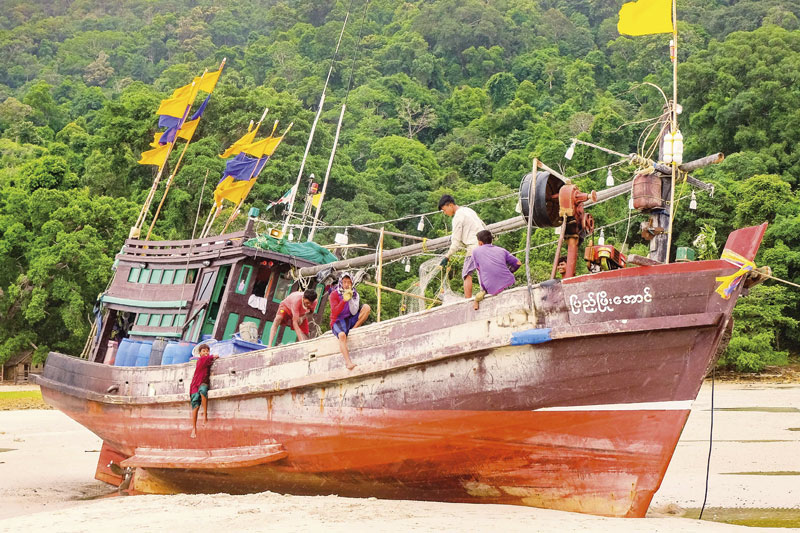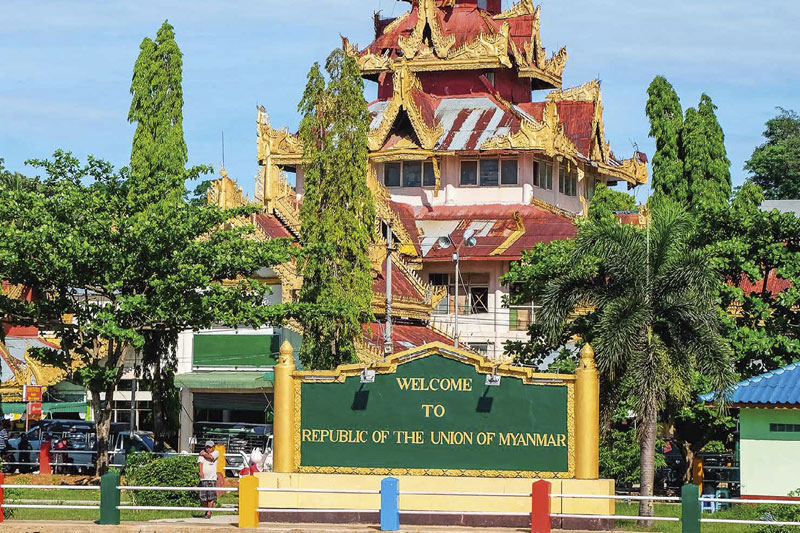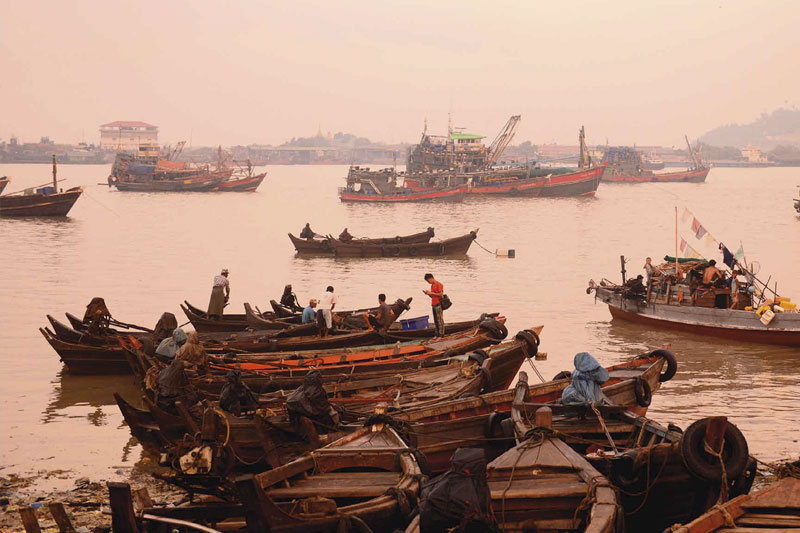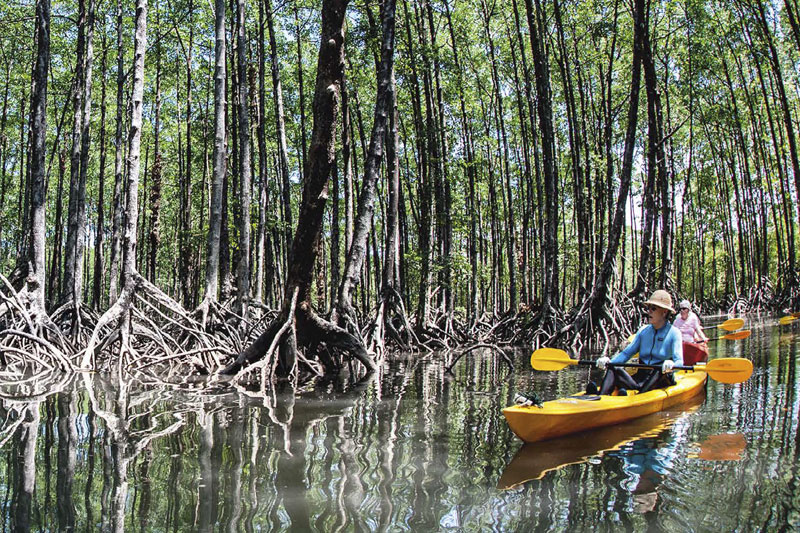
Unplugged in Paradise
Need an e-tox? Then head for one of Asia’s fast unspoiled destinations – the Myeik Archipelago in Myanmar.
Words & Photos Ron Emmons
My phone and laptop were beginning to control my life, and I was badly in need of an e-tox. I couldn’t bear to throw these gadgets away, so I decided to go far, far away; somewhere without Wi-Fi or 3G; somewhere I could escape from the virtual world and reconnect with nature.
Allowing myself one last online indulgence to search for my spot, I signed up with Moby Dick Tours for a cruise through the Myeik (aka Mergui) Archipelago, located in the Andaman Sea off the southern coast of Myanmar.
The indicators were good: over 800 tropical islands, some no bigger than a house and others several kilometres long and wide; most of them uninhabited; no ferries connecting them, and definitely no Wi-Fi.
The trip began in Kawthaung, Myanmar’s southernmost town, where I boarded the Sea Gypsy – a homely looking, yellow and green-painted vessel with simple accommodation for 10 people, a communal sitting and eating area, a sundeck and a perpetually smiling crew. My companions for the voyage were a bunch of like-minded travellers from the USA, the UK, Ireland, Belgium, Switzerland, Germany and Thailand.

Our tour guide, JoJo, briefed us on our activities for the next five days. These included exploring the islands and beaches, swimming, sunbathing, snorkelling, kayaking and stand-up paddleboarding (SUP), visiting a Moken (sea nomad) village, meeting local fishermen, eating delicious food and getting to know each other.
JoJo handed each of us a map of the area, and I smiled to see the names of some islands, such as Hastings Island, Lord Loughborough Island and Great Swinton Island, which I presumed were named by ship captains in the era of British rule over Burma. I had read that the region was once a hotbed of pirates, but I hoped we would complete our cruise without seeing a ship with a Jolly Roger flag of skull and bones bearing down on us.
Within a couple of hours heading northwest into the archipelago, we had lost sight of the mainland and were surrounded by islands that were covered in dense forest and ringed by rocky shorelines, sandy beaches and coral reefs. Soon the Sea Gypsy dropped anchor and JoJo whisked us to a deserted beach in a small dinghy. We scrambled up a steep incline to enjoy a panoramic view of the archipelago, but we didn’t stay there long. Suddenly everything went dark and the heavens opened; rain came teeming down, thunder cracked and lightning split the sky. By the time we got back to the boat we were all soaked, despite not yet having had a swim in the sea.
Our voyage took place at the turn of the dry to rainy season, and stormy weather became a regular feature of the next few days. While in some ways this was disappointing, the storms brought with them a silver lining in the form of dramatic skies that made for memorable photos. I would find myself composing an image with bright sunlight shining on the Sea Gypsy or on one of our group paddleboarding over limpid waters, with a contrasting backdrop of dark, brooding clouds.
As we chugged around the archipelago, we often spotted dolphins breaking the surface near our boat, and eagles and kites gliding on air currents high above us. With its relative lack of human activity, the archipelago is a haven for many rare creatures, such as dugongs, dusky langurs and plain-pouched hornbills. We didn’t see any of these, but one day I was taking shots of yet another idyllic, deserted beach when someone shouted “Oh, look at the monkeys!” I swung my camera round to see that the ‘monkeys’ were in fact a family of oriental small-clawed otters scampering down the beach to the sea. Apparently, they are different to other otters in that they spend most of their time on land, and catch their prey with their paws rather than with their mouths.

Though the islands are largely devoid of any human footprint, one saddening sight was the pollution on several beaches. Plastic bottles, torn fishing nets and lumps of Styrofoam marked the high-tide line, posing a grave danger to the many endangered species that inhabit the archipelago. Coral reefs are also under threat, not only from rising sea temperatures, but also from carelessly dropped boat anchors and tourists taking souvenirs of their trip, though I was glad that JoJo warned us against this last activity. Unfortunately, due to the stormy weather, visibility on the reefs was poor so we couldn’t fully appreciate their beauty at the time of our trip.
At present, only a few resorts exist in the entire archipelago, each of which professes to be eco-friendly and to keep human impact to a minimum. However, several other luxury resorts are currently under construction on previously uninhabited islands, and hopefully they will take a similarly sensitive approach to this fragile wonderland.
The only permanent inhabitants of the archipelago are the Moken, an Austronesian people who number just a couple of thousand. In the past they would spend nine months of the year moving around the islands, free diving for food from their dugout canoes, then sheltering on land during the monsoon season. These days they live most of the time on land, and we visited one of their villages on Nyaung Wee Island.

We found them friendly and welcoming, and we were able to watch them repairing their canoes and thatching huts while their children played on the beach. One of the local Moken women told us that they are trying to hold on to their traditional lifestyle despite intermarriage and modernisation, but she was doubtful whether they would be successful.
We also visited a group of Myanmar fisherfolk who spend most of their life at sea, fishing for squid at night. They offered us beers and bags of squid and kept up a constant jovial banter, while one of them was dismantling a boat engine, his hands black with grease, and a young boy showed off his mobile phone loaded with games.
However, the highlight of the whole trip for me was on the last day, when we went ashore on Taung Lao Bo Island to find some maroon and beige rocks that made a striking contrast to the pale turquoise waters of the bay. While others in the group were kayaking and paddleboarding, I waded through the shallows with my camera, delighted by the swirling, natural patterns in the wave-worn rocks.
We had such a good time in the Myeik Archipelago that most of us completely forgot about our phones. That is, until one of our group shouted “I’ve got a signal!” as the Sea Gypsy approached the mainland at the end of our tour. After five days of socialising, suddenly everyone went silent, their eyes glued to a screen, as they checked long lists of emails, sent messages to friends and made arrangements for onward travel. I have to confess that I was as bad as everyone else – totally addicted to the virtual world – until the sky flared into a jaw-dropping sunset, a fitting end to our unplugged sojourn in paradise.

เมื่อมือถือและคอมพิวเตอร์เข้ามาครอบงำชีวิตเรามากเกินไป ทางออกเดียวคือหนีไปให้ไกล ไปยังที่ที่ปราศจากโลกออนไลน์เพื่อหล่อหลอมเป็นหนึ่งเดียวกับธรรมชาติอีกครั้ง และคงไม่มีที่ไหนเหมาะไปกว่าหมู่เกาะมะริดในทะเลอันดามันทางตอนใต้ของประเทศเมียนมาร์
ทริปของเราเริ่มที่เกาะสอง ใต้สุดของเมียนมาร์ เราขึ้นเรือที่มีที่พักสำหรับ 10 คน พร้อมกับนักเดินทางจากฝั่งอเมริกา ยุโรป และรวมถึงคนไทยด้วย โจโจ้ ไกด์นำเที่ยวของเราแนะนำกิจกรรมที่จะเกิดขึ้นในอีก 5 วันหลังจากนี้ ทั้งเที่ยวเกาะ ว่ายน้ำ อาบแดด ดำน้ำ พายเรือคายัก ทำความรู้จักหมู่บ้านชาวมอแกน และพาชิมอาหารเลิศรส
หลังออกเดินทางเพียงไม่กี่ชั่วโมง แผ่นดินก็หายไปจากสายตา กลายเป็นเกาะแก่งที่ปกคลุมไปด้วยป่าเขียวขจี ภูเขาเลียบชายฝั่ง หาดทรายละเอียด และปะการังงดงาม เมื่อเรื่อ Sea Gypsy ทอดสมอ โจโจ้พาเราลงเรือเล็กเพื่อมุ่งหน้าไปยังชายหาดเวิ้งว้าง เราค่อยๆ ปีนเขาสูงชันเพื่อชมทิวทัศน์ที่ทอดยาวสุดลูกหูลูกตาของหมู่เกาะมะริด ทันใดนั้น ท้องฟ้าก็มืดทึม ฝนกระหน่ำลงมาอย่างหนัก เรากลับขึ้นเรือเนื้อตัวเปียกโชนขณะเดียวกับที่ฟ้าร้องกึกก้อง
ช่วงเข้าหน้ามรสุม ฝนฟ้าคะนองเป็นเรื่องปกติ ซึ่งแม้จะน่าผิดหวังอยู่บ้าง แต่ไม่นานแสงอาทิตย์สีทองที่งดงามจนแทบลืมหายใจก็ส่องทาบทาก้อนเมฆ เหมาะแก่การถ่ายภาพท่ามกลางแสงแดดจ้าหรือพายเรือเล็กท่ามกลางน้ำนิ่งสงบโดยมีฉากหลังเป็นเมฆสีเข้มก็งดงามไม่แพ้กัน ระหว่างแวะตามเกาะแก่งทั้งหลาย เราเห็นโลมากระโดดขึ้นพ้นน้ำและนกอินทรีย์โผบิน หมู่เกาะมะริดเป็นถิ่นอาศัยของสัตว์หายากอีกหลายชนิดอย่าง พะยูน ค่างแว่น และนกเงือกกรามช้างปากเรียบ เพื่อนักท่องเที่ยวที่ไปด้วยกันตะโกนขึ้นมาด้วยความตื่นเต้นเมื่อเห็น “ลิง” บนชายหาด ซึ่งแท้จริงแล้วคือตัวนากเล็บสั้นที่พากันวิ่งโลดลงทะเล
แม้ว่าจะไม่มีคนอยู่บนเกาะ แต่เราก็ยังเห็นขวดพลาสติก ซากอวน และโฟมที่พัดมาตามเกลียวคลื่น ปะการังถูกทำลายทั้งจากอุณหภูมิที่สูงขึ้น การทิ้งสมอเรืออย่างไม่ระมัดระวังและนักท่องเที่ยวที่เก็บปะการังติดไม้ติดมือกลับบ้าน
ปัจจุบันมีรีสอร์ตเพียงไม่กี่แห่งอยู่บนหมู่เกาะมะริด รีสอร์ตทุกแห่งเป็นมิตรต่อระบบนิเวศ พยายามลดผลกระทบจากมนุษย์ให้น้อยที่สุด ขณะที่เรามาเยี่ยมเยือนหมู่เกาะแห่งนี้กำลังก่อสร้างรีสอร์ตหรูขึ้นหลายแห่ง เราได้แต่หวังว่ารีสอร์ตเหล่านี้จะใส่ใจสิ่งแวดล้อมอย่างที่ควรจะเป็น
ผู้อยู่อาศัยเพียงกลุ่มเดียวบนเกาะมะริดคือชนเผ่ามอแกน แต่ก่อนชาวมอแกนใช้ชีวิตเก้าเดือนเดินทางจากเกาะหนึ่งไปอีกเกาะหนึ่ง ส่วนอีกสามเดือนที่เหลือจะอยู่บนแผ่นดินเนื่องจากอากาศแปรปรวนในช่วงมรสุม ชาวมอแกนบนเกาะฮาวิต้อนรับพวกเราอย่างอบอุ่น เราได้เห็นชาวมอแกนซ่อมเรือแคนู มุงหลังคากระท่อม และเด็กๆ วิ่งเล่นบนชายหาด ชาวมอแกนเล่าให้ฟังว่า พวกเขาพยายามอย่างหนักเพื่อรักษาวัฒนธรรมของตัวเอง เอาไว้ท่ามกลางสภาพสังคมที่แปรเปลี่ยน จากนั้นเราก็ได้พบปะกับชาวประมงที่ใช้ชีวิตส่วนใหญ่ในท้องทะเล ร่วมกันดื่มเบียร์ ตกหมึก ซ่อมเรือ ดูโทรศัพท์มือถือของชาวประมงตัวน้อยที่ดาวน์โหลดเกมไว้เต็มเครื่อง
ไฮไลต์สุดแสนประทับใจอยู่ที่วันสุดท้ายเป็นความงดงามแปลกตาที่คงไม่มีวันลืมเลือน เมื่อได้มีโอกาสชมความงามของหินสีน้ำตาลแดงและหินสีน้ำตาลอ่อนตัดกับน้ำทะเลสีน้ำเงินอมเขียวบนเกาะ Taung Lao Bo
ห้าวันที่ผ่านไปบนหมู่เกาะมะริดช่างเป็นช่วงเวลาแสนสุข จนกระทั่งมีใครสักคนตะโกนขึ้นมาว่า “มีสัญญาณแล้ว” ทุกคนกลับไปก้มหน้ามองหน้าจอ เช็คอีเมลและข้อความที่คนทางไกลส่งมา ไม่มีใครพูดคุยกันอีกแล้ว เราทุกคนยังคงเสพติดโลกออนไลน์เหมือนเคย กระทั่งท้องฟ้าสว่างผลัดเปลี่ยนเป็นท้องฟ้ายามอาทิตย์อัสดงงดงามจนทุกคนอ้าปากค้าง นับเป็นการจบทริปแบบไม่ต้องพึ่งอินเตอร์เน็ตได้สมบูรณ์แบบอย่างแท้จริง
ทริคเพื่อทริป
ช่วงที่เหมาะสม: ตุลาคม-เมษายน
ติดต่อ: Moby Dick Tours (islandsafarimergui.com)
การเดินทาง: ทัวร์ออกเดินทางจากเกาะสองในเมียนมาร์ สามารถนั่งเครื่องบินไปจากย่างกุ้งหรือนั่งเรือหางยาวจากระนองได้
ค่าใช้จ่ายอื่นๆ: วีซ่าอิเล็กทรอนิกส์ 50$ ค่าเข้าหมู่เกาะมะริด 100$
